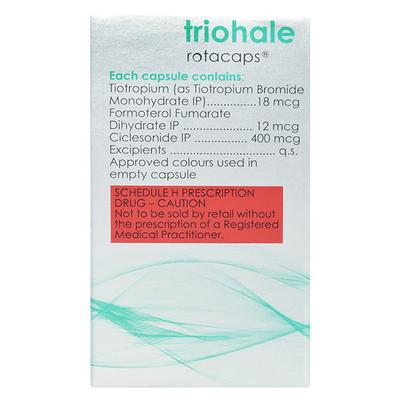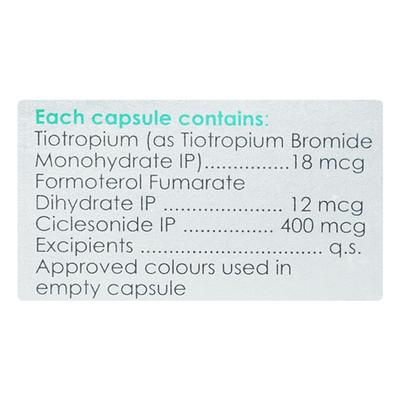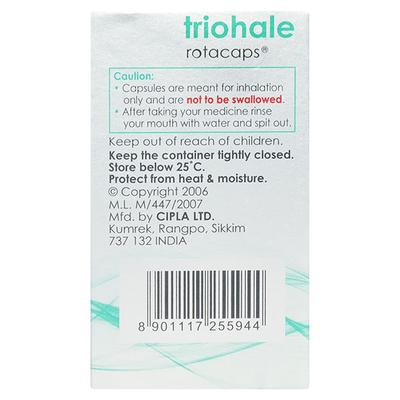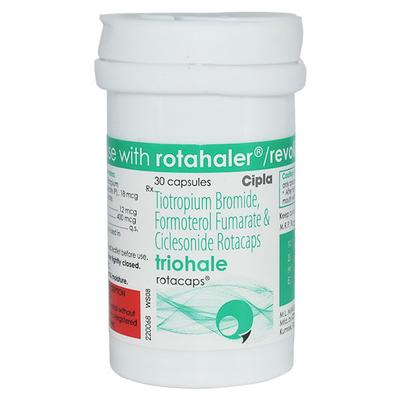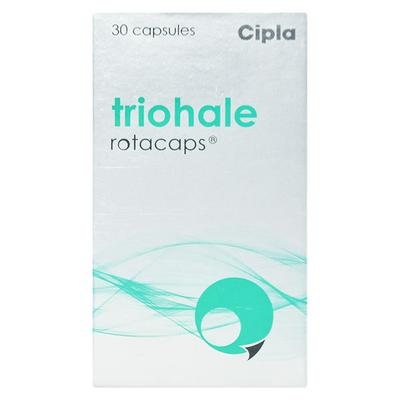

Netmeds First Membership
Quick Links
Introduction About TRIOHALE ROTACAP
TRIOHALE ROTACAP is a combination of Ciclesonide, Formoterol and Tiotropium which belongs to the group of medicines called Steroids and Bronchodilators respectively. It is indicated in the symptomatic management of severe COPD (Chronic Obstructive Pulmonary Disease) and a history of repeated exacerbations, having significant symptoms despite regular management with long-acting bronchodilators.
Before taking TRIOHALE ROTACAP, inform your doctor if you have kidney or heart diseases, active or inactive pulmonary tuberculosis, fungal, viral, or bacterial infections, increased pressure in the eye, an enlarged prostate, thyrotoxicosis, or bladder-neck obstruction.
TRIOHALE ROTACAP should be used with caution in pregnant or breastfeeding women. TRIOHALE ROTACAP should not be used by children under the age of 12. Headache, muscle cramps, faster heart rate, dry mouth, oropharyngeal candidiasis (fungal), hoarseness, and cough are the most common side effects of using TRIOHALE ROTACAP. Ask for your doctor’s advice if any of these worsen or don’t improve.
Uses Of TRIOHALE ROTACAP
- Manage the symptoms associated with COPD
- Manage patients having a history of repeated exacerbations
- Manage symptoms even after using other bronchodilators
How TRIOHALE ROTACAP Works
TRIOHALE ROTACAP helps in the management of symptoms of COPD where Ciclesonide is a glucocorticoid which possesses anti-inflammatory action. It inhibits the potent factors that cause inflammation such as prostaglandins and leukotrienes.
Formoterol is an Adrenergic beta-2 Receptor Agonist, which acts on the receptors present in the airways called beta-receptors and causes the relaxation of muscles in the airways resulting in easy breathing. It also suppresses the release of agents that cause hypersensitivity (histamine and leukotrienes).
Tiotropium is an Anticholinergic drug which causes relaxation of the muscles in the airways and bronchodilation. Together, they help in easy breathing and decrease inflammation.
How to use TRIOHALE ROTACAP
Always use TRIOHALE ROTACAP as directed by your physician. It is for inhalational use only. Your doctor will advise the correct dose and duration of TRIOHALE ROTACAP for you depending upon your age, condition and body weight.
Side Effects Of TRIOHALE ROTACAP
Common
- headache
- muscle cramps
- faster heart rate
- dry mouth
- oropharyngeal candidiasis(fungal)
- hoarseness
- cough
Rare
Stop taking TRIOHALE ROTACAP and inform your doctor if you experience any of the following side effects:
- paradoxical bronchospasm (constriction of airways after management with certain bronchodilators)
- temporary blurring of vision, eye pain or discomfort, visual halos or red eyes
- angioedema (difficulty in breathing, swallowing, swelling of skin surfaces)
How To Manage Side Effects
Headache
Try to take a rest and don’t involve yourself in exertive activities. Apply a pain-relieving balm on your forehead. If the symptom does not improve, consult with your doctor.
Warning & Precautions
Pregnancy
RiskyThere are no adequate studies on the use of TRIOHALE ROTACAP in pregnant women. It should only be given if the expected benefit to the mother is greater than any risk to the foetus. Consult your doctor before taking it.
Breastfeeding
RiskyIt is not known whether TRIOHALE ROTACAP passes through breast milk or not. It should only be given if the expected benefit to the mother is greater than any possible risk to the child. Consult your doctor before taking it.
Kidney
Use with CautionTRIOHALE ROTACAP should be used with caution in patients having moderate to severe kidney diseases. Consult with your doctor before taking it.
Allergy
ContraindicatedDo not take TRIOHALE ROTACAP if you are allergic to Ciclesonide, Formoterol or Tiotropium.
Heart Disease
Use with CautionTRIOHALE ROTACAP should be used with caution in patients having heart diseases such as Ischaemic heart disease, irregular heartbeat, 3rd-degree atrioventricular block, severe cardiac decompensation (sudden onset of symptoms of heart failure), idiopathic subvalvular aortic stenosis (reduced blood flow in the heart due to obstruction), hypertrophic obstructive cardiomyopathy (abnormally thickening of heart muscles). Consult with your doctor before taking it.
Use In Pediatrics
ContraindicatedTRIOHALE ROTACAP is not recommended for use in children below 12 years of age. Consult your doctor before taking.
Use In Geriatrics
Consult your doctorYour doctor will decide the correct dose and duration of the management with TRIOHALE ROTACAP for you depending upon your age, condition and body weight. Consult your doctor.
Others
Before taking TRIOHALE ROTACAP inform your doctor if you have:
- active or inactive pulmonary tuberculosis
- fungal, viral or bacterial infections
- increased pressure in the eye
- enlarged prostate
- thyrotoxicosis (excessive thyroid hormone in the blood)
- bladder-neck obstruction
Interactions
A. Drug–Drug Interactions:
Before taking TRIOHALE ROTACAP, inform your doctor if you are taking any of the following medicines:
- other anticholinergic drugs such as atropine (used to manage asthma), xanthine derivatives such as theobromine and methylxanthines (used to manage bronchospasm)
- steroids such as prednisolone (used to reduce inflammation and pain)
- diuretics such as spironolactone, and furosemide (used to get rid of extra fluid from the body)
- monoamine oxidase inhibitors such as isocarboxazid, tricyclic antidepressants such as amitriptyline, and doxepin (used to manage depression)
- ketoconazole, itraconazole (used to manage fungal infections)
- ritonavir, nelfinavir (used to manage HIV infection)
Overdosage:
If you or anyone else accidentally take too much of TRIOHALE ROTACAP, consult your doctor immediately or visit the nearby hospital.
Synopsis
| Drug | : | Flupirtine |
| Pharmacological Category | : | Glucocorticoid, Adrenergic beta-2 Receptor Agonists, Anticholinergics |
| Therapeutic Indication | : | Chronic Obstructive Pulmonary Disease |
| Dosage Forms | : | Inhalers, Rotacaps, Transcaps |
More Information
- Keep TRIOHALE ROTACAP out of reach from children
- Store below 30°C
FAQs About TRIOHALE ROTACAP
Q: What is TRIOHALE ROTACAP and why is it prescribed?
A: TRIOHALE ROTACAP is a combination of Ciclesonide, Formoterol, and Tiotropium, which belong to the groups of medicines called steroids and bronchodilators, respectively. It is indicated in the symptomatic management of severe COPD with a history of repeated exacerbations and significant symptoms despite regular management with long-acting bronchodilators.
Q: Can TRIOHALE ROTACAP cause dry mouth?
A: Yes. TRIOHALE ROTACAP can cause dry mouth. This can increase the likelihood of dental caries occurring. It is advised to always rinse your mouth after taking TRIOHALE ROTACAP.
https://www.pcrs-uk.org/sites/pcrs-uk.org/files/RespInhalerTable_FINAL_0.pdf
Q: How to use TRIOHALE ROTACAP
A: Always use TRIOHALE ROTACAP as directed by your physician. It is for inhalational use only. Your doctor will advise the correct dose and duration of TRIOHALE ROTACAP for you depending upon your age, condition, and body weight.
Q: Is TRIOHALE ROTACAP a steroid?
A: TRIOHALE ROTACAP is a combination of three medicines, namely, clesonide, formoterol, and tiotropium. Ciclesonide is a steroid that has an anti-inflammatory action. It inhibits the potent factors that cause inflammation, such as prostaglandins and leukotrienes.
Q: Is it safe for children to TRIOHALE ROTACAP?
A: TRIOHALE ROTACAP should not be used by children under the age of 12. Consult your doctor before taking it.
References
1. K.D. Tripathi. Drugs Acting on ANS, Drugs for Bronchial Asthma and Cough. Essentials of medical pharmacology. Seventh edition. 2013. Page – 117, 224 & 231.
2. Salvi SS, Vaidya AJ, Kodgule RR, Gogtay JA. A randomized, double-blind study comparing the efficacy and safety of a combination of formoterol and ciclesonide with ciclesonide alone in asthma subjects with moderate-to-severe airflow limitation. NIH National Library of Medicine, National center for biotechnology information. Pubmed Central. May-June 2016. [Accessed on 8th July 2022] https://www.ncbi.nlm.nih.gov/pmc/articles/PMC4857562/
3. NIH National Library of Medicine, National center for biotechnology information. Pubchem. Ciclesonide. [Accessed on 8th July 2022] https://pubchem.ncbi.nlm.nih.gov/compound/Ciclesonide
4. NIH National Library of Medicine, National center for biotechnology information. Pubchem. Formoterol. [Accessed on 8th July 2022] https://pubchem.ncbi.nlm.nih.gov/compound/Formoterol
5. NIH National Library of Medicine, National center for biotechnology information. Pubchem. Tiotropium. [Accessed on 8th July 2022] https://pubchem.ncbi.nlm.nih.gov/compound/Tiotropium
6. Dr Anna Murphy. Primary Care Respiratory Society UK. Respiratory Inhalers. [Revised in December 2014]. [Accessed on 8th July 2022] https://www.pcrs-uk.org/sites/pcrs-uk.org/files/RespInhalerTable_FINAL_0.pdf
7. Cipla Ltd. Triohale Rotacaps. Ciplamed. [Revised in December 2015]. [Accessed on 8th July 2022] https://www.ciplamed.com/content/triohale-rotacaps
8. Cipla Ltd. Triohale Inhalers. Ciplamed. [Revised in December 2015]. [Accessed on 8th July 2022] https://www.ciplamed.com/content/triohale-inhaler
Useful Diagnostic Tests
- Chest Xray
- Complete Blood Count









